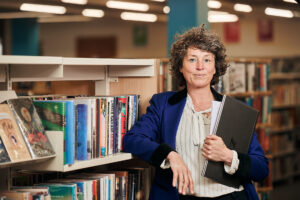Breaking barriers to inclusive education with digital solutions
Education should be a level playing field, but in reality this can be hard to achieve despite the best efforts of families and schools.

Some students face challenges that go beyond the capacity of schools to provide for — whether due to staffing shortages, expertise constraints, or the growing complexity student needs. What is clear, is it does not stop brilliant schools across the country trying.
Despite these obstacles, schools and education providers are finding innovative ways to make inclusion a reality—often with the help of digital solutions. It prompts us to ask, “What does it mean to go to school nowadays?” During the pandemic, this question had a completely different answer, and today this answer continues to evolve.
Digital tools are facilitating access to expert teachers, specialist support, and a range of dynamic teaching methods to make learning more effective and—above all else—inclusive for all students.
But what does inclusive education truly mean, and how can technology ensure that no gap is left uncovered?
What is inclusive education?
Inclusive education is the principle of providing all students with the same level of access to education and the same quality curriculum and support despite their differences. Differences that are to be celebrated!
It addresses the barriers students with SEN or disabilities typically face in schools. For example, some parts of a school could be less readily accessible for a student, or the text in a schoolbook could be more challenging to read, making it difficult for some students to engage.
Educators can contribute to a more inclusive educational setting by adopting effective teaching practices considering every student’s needs. However, some barriers remain and removing them is an ongoing mission.
Challenges in achieving inclusive education
The hurdles to inclusive education are well-documented. Many schools struggle to recruit and retain specialist staff, leaving gaps in their ability to meet the needs of all students. Student needs are becoming increasingly complex, and supporting these requires specialised resources.
A lack of budget can also limit schools’ efforts to invest in the right tools, external support, or programmes. Positive changes to the conditions schools operate are welcome but these changes take time to implement.
In the meantime, schools need practical, immediate ways to adapt. This is where digital innovation makes a real impact, offering flexible and scalable solutions that directly address any barrier students may face. Indeed, Dr Fiona Aubrey-Smith’s work shows that simply digitising traditional learning tasks increased capacity for learning by 23%.

The role of digital solutions in Internal Alternative Provisions
Internal Alternative Provisions (IAPs) have many names—from inclusion rooms to nurture rooms or reset spaces—but they all mean the same thing. IAPs deliver an alternative provision (one with specialised academic and/or wellbeing support) internally, within the school environment.
Importantly, these provisions are designed to be flexible, enabling students to continue their education despite challenges – and succeed in their learning just as much as any other student.
Here are some concrete examples of how technology can be used in IAP settings to improve its effectiveness:
- Live, adaptive teaching enables students to connect with subject-specialist teachers, often in small classes (Academy21’s class sizes are limited to 15 pupils), so the teacher can understand each student’s learning needs and tailor each lesson to them.
- AI-driven learning platforms like InspiredAI, which Academy21 leverages, offer a personalised learning pathway for each student based on their strengths and weaknesses, as well as general pace and understanding.
- Assistive technologies include tools like text-to-speech software, digital note-taking aids, dyslexia-friendly fonts, and modelling answers. They help students with specific learning challenges to learn effectively.
- Enhanced learning through collaborative tools like polls and quizzes and fully immersive virtual reality experiences that make concepts more engaging, interesting, and easy to digest.
Technology is easily scalable and adaptable to students’ and schools’ needs. An online alternative provision like Academy21 can be deployed within days, and the service can scale up and down as needed to match fluctuating demand, so schools can be truly inclusive without overextending existing resources or committing budget.
It is also flexible regarding location—students don’t have to be stuck in a noisy classroom, dealing with sensory overload or the pressure to keep up with their peers. If their class is entirely online, students can attend it from wherever is most convenient, whether in an inclusion room within their mainstream school, home, or a medical setting.

Early intervention: Investing for the future
Effective inclusion starts with early intervention. Research consistently shows that addressing challenges before they escalate leads to better student outcomes and reduces long-term costs for schools. Digital solutions are uniquely positioned to support this proactive approach.
For instance, AI-driven platforms can identify learning gaps early, providing educators with actionable insights to tailor support. Online teaching can quickly scale up to meet the needs of students requiring short-term or long-term interventions, offering continuity in their education regardless of circumstances.
For example, students suspended or excluded may face delays in securing appropriate school placements. During this waiting period, they risk becoming disconnected from learning, especially if interim educational support is insufficient.
In the UK, the rate of suspensions was 4.13 (equivalent to 413 suspensions for every 10,000 pupils) during the autumn term of 2023/2024. This is higher than the previous autumn term’s 2.96 and higher than the autumn term 2019/20 rate of 2.17. Permanent exclusions are also increasing, making adaptable alternative provision an invaluable solution.
Although implementing these solutions involves an upfront cost, the long-term benefits are undeniable. Schools that invest wisely in digital tools often save money over time by creating sustainable support systems.
Building an inclusive future
We can ask of our education settings: to what extent is children’s learning being defined by the capacity of the setting? Even the most skilled educators face limits without the right resources and tools.
Adopting digital solutions for inclusive education may offer a quickly deployable support in some cases. However, the benefits of technology in education are long-lasting. Schools that embrace technology as part of their inclusion strategies create environments where every student has the tools they need to succeed.
The benefits extend to schools, too: With the ability to quickly deploy provisions like Academy21 within just 48 hours and adapt the length and extent of the service to match changing needs, schools can plan clearly for the future and track and demonstrate results without any unexpected costs.
Based on EEF’s recent study plan, a commitment to integrated, extensive, ongoing, and tailored support is a key aspect of IAP. To implement these technologies effectively, schools need a strategy that aligns with their goals and focuses on pupil-centred outcomes. By combining digital tools with solid leadership and inclusive values, educators can break down barriers and create lasting change.
Written by
Sam Holderness
Posted on
04/12/2024
Updated on
29/08/2025
Topic
Student successPost type
Blog


